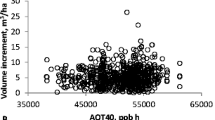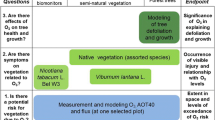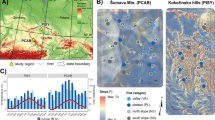Abstract
We investigated the significance of tropospheric ozone as a factor explaining recent tree health (in terms of defoliation) and productivity (in terms of basal area increment, BAI) in 15 ICP Forests level I and one level II plots in alpine forests in Trentino (N. Italy). Mean daily ozone summer concentrations varied between 30 and 72 parts per billion (ppb) leading to large exceedance of concentration-based critical levels set to protect forest trees. Phytoxic ozone dose (POD0) estimated at the level II plot over the period 1996–2009 was 31–61 mmol m−2 projected leaf area (PLA). The role of ozone was investigated taking into account other site and environmental factors. Simple linear regression, multiple linear regression (MLR, to study mean periodical defoliation and mean periodical BAI), and linear mixed models (LMM, to study annual defoliation data) were used. Our findings suggest that—regardless of the metric adopted—tropospheric ozone is not a significant factor in explaining recent status and trends of defoliation and BAI in the alpine region examined. Both defoliation and BAI are in turn driven by biotic/abiotic damage, nutritional status, DBH (assumed as a proxy for age), and site characteristics. These results contrast with available ozone-growth dose response relationships (DRRs) and other observational studies. This may be due to a variety of concurrent reasons: (i) DRRs developed for individual saplings under controlled condition are not necessarily valid for population of mature trees into real forest ecosystems; (ii) some observational studies may have suffered from biased design; and (iii) since alpine forests have been exposed to high ozone levels (and other oxidative stress) over decades, possible acclimation mechanisms cannot be excluded.




Similar content being viewed by others
References
Ashmore MR (2005) Assessing the future global impacts of ozone on vegetation. Plant Cell Environ 28(8):949–964. https://doi.org/10.1111/j.1365-3040.2005.01341.x
Augustaitis A, Bytnerowicz A (2008) Contribution of ambient ozone to Scots pine defoliation and reduced growth in the Central European forests: a Lithuanian case study. Environ Pollut 155(3):637–646. https://doi.org/10.1016/j.envpol.2008.01.042
Blanchet FG, Legendre P, Borcard D (2008) Forward selection of explanatory variables. Ecology 89(9):2623–2632. https://doi.org/10.1890/07-0986.1
Braun S, Schindler C, Rihm B (2014) Growth losses in Swiss forests caused by ozone: epidemiological data analysis of stem increment of Fagus sylvatica L. and Picea abies Karst. Environ Pollut 192:129–138. https://doi.org/10.1016/j.envpol.2014.05.016
Braun S, Schindler C, Rihm B (2017) Growth trends of beech and Norway spruce in Switzerland: the role of nitrogen deposition, ozone, mineral nutrition and climate. Sci Total Environ 599:637–646. https://doi.org/10.1016/j.scitotenv.2017.02.225
Büker P, Feng Z, Uddling J, Briolat A, Alonso R, Braun S, Elvira S, Gerosa G, Karlsson PE, Le Thiec D, Marzuoli R, Mills G, Oksanen E, Wieser G, Wilkinson M, Emberson LD (2015) New flux based dose - response relationships for ozone for European forest tree species. Environ Pollut 206:163–174. https://doi.org/10.1016/j.envpol.2015.06.033
Bussotti F (2008) Functional leaf traits, plant communities and acclimation processes in relation to oxidative stress in trees: a critical overview. Glob Chang Biol 14:2727–2739
Bussotti F, Ferretti M (2009) Visible injury, crown condition, and growth responses of selected Italian forests in relation to ozone exposure. Environ Pollut 15(5):1427–1437. https://doi.org/10.1016/j.envpol.2008.09.034
Bussotti F, Cozzi A, Cenni E, Bettini D, Sarti C, Ferretti M (2009) Quality assurance and measurement errors in monitoring tree crown conditions in Italy. J Environ Monit 11(4):769–773. https://doi.org/10.1039/b818166g
CLC Corine Land Cover (2000) http://land.copernicus.eu/pan-european/corine-land-cover. Accessed 05 Sept 2017
CLRTAP (2004) Mapping critical levels for vegetation (chapter 3) In: Manual on methodologies and criteria for modelling and mapping critical loads and levels and air pollution effects, risks and trends. 86 pp. Federal Environmental Agency (Umweltbundesamt), Berlin. ISSN: 0722-186X
CLRTAP (2014) Guidance on mapping concentrations levels and deposition levels, chapter III of manual on methodologies and criteria for modelling and mapping critical loads and levels and air pollution effects, risks and trends. UNECE Convention on Long-Range Transboundary Air Pollution. Accessed 23 March 2017 at www.icpmapping.org
Cooper OR, Parrish DD, Ziemke J, Balashov NV, Cupeiro M, Galbally IE et al (2014) Global distribution and trends of tropospheric ozone: an observation-based review. Elem Sci Anth 2:29. https://doi.org/10.12952/journal.elementa.000029
Cristofolini F, Cristofori A, Gottardini E, Maccherini S, Ferretti M (2011) Constraints in the identification and interpretation of ozone as a significant predictor of effects on the supersensitive indicator Nicotiana tabacum Bel-W3 in biomonitoring studies. Ecol Indic 11(5):1065–1073. https://doi.org/10.1016/j.ecolind.2010.12.003
Cristofori A, Bacaro G, Confalonieri M, Cristofolini F, Frati L, Geri F, Gottardini E, Tonidandel G, Zottele F, Ferretti M (2015) Estimating ozone risks using forest monitoring networks—results for science, policy, and society. Ann Forest Sci 72(7):887–896. https://doi.org/10.1007/s13595-014-0440-y
Directive 2008/50/EC of the European Parliament and of the Council of 21 May 2008 on Ambient Air Quality and Cleaner Air for Europe. Official Journal of the European Union, L 152. 44 p. Volume 51, 11 June 2008. https://eur-lex.europa.eu/legal-content/en/ALL/?uri=CELEX:32008L0050/
Dray S, Legendre P, Blanchet G (2016) Packfor: forward selection with permutation. R package version 0.0-8 http://R-Forge.R-project.org
Eccel E, Saibanti S (2005) Climatic setting of the Lavarone-Vezzena Plateau in the general context of Trentino. Studi Trent Sci Nat Acta Geol 82:111–121 ISSN 0392-0534
EEA (2014) Air pollution by ozone across Europe during summer 2013—overview of exceedance of EC ozone thresholds values: April–September 2013. EEA Technical Report No. 3/2014: 51 ps. ISSN 1725-2237
Eichhorn J, Roskams P, Potočić N, Timmermann V, Ferretti M, Mues V, Szepesi A, Durrant D, Seletković I, Schröck H-W, Nevalainen S, Bussotti F, Garcia P, Wulff S (2016) Part IV: visual assessment of crown condition and damaging agents. In: UNECE ICP Forests Programme Coordinating Centre (ed.): Manual on methods and criteria for harmonized sampling, assessment, monitoring and analysis of the effects of air pollution on forests. Thünen Institute of Forest Ecosystems, Eberswalde, Germany, 54 p. [http://www.icp-forests.org/Manual.htm]
Emberson LD, Ashmore MR, Cambridge HM, Simpson D, Tuovinen J-P (2000) Modelling stomatal ozone flux across Europe. Environ Pollut 109(3):403–413. https://doi.org/10.1016/S0269-7491(00)00043-9
Emberson LD, Ashmore MR, Simpson D, Tuovinen JP, Cambridge HM (2001) Modelling and mapping ozone deposition in Europe. Water Air Soil Pollut 130(1/4):577–582. https://doi.org/10.1023/A:1013851116524
Felzer BS, Reilly JM, Melillo JM, Kicklighter DW, Wang C, Prinn RG, Sarofim M, Zhuang Q (2004) Past and future effects of O3 on net primary production and C sequestration using a global biogeochemical model. Joint Program Report Series Report 103, October (revised January 2004), 27 pages. http://globalchange.mit.edu/publication/14314. Accessed 05 Sept 2017
Ferretti M (2013) Concepts and design principles adopted in the international cooperative program on the assessment and monitoring of air pollution effects on forests (ICP Forests). In: Ferretti M, Fischer R (eds) Forest Monitoring, vol 12. Elsevier, DENS, pp 91–104
Ferretti M, Bussotti F, Cenni E, Cozzi A (1999) Implementation of quality assurance procedures in the Italian programs of forest condition monitoring. Water Air Soil Pollut 116(1/2):371–376. https://doi.org/10.1023/A:1005240000294
Ferretti M, Bussotti F, Fabbio G, Petriccione B (2003) Ozone levels, actual and potential effects on the vegetation at the Permanent Monitoring Plots of the CONECOFOR programme in Italy—achievements, problems and perspectives. In: Ferretti M, Bussotti F, Fabbio G, Petriccione B (Eds.) Ozone and forest ecosystems in Italy. Second report of the Task Force on Integrated and Combined (I&C) evaluation of the CONECOFOR programme. Annali Istituto Sperimentale per la Selvicoltura, Special Issue, Arezzo Anno 1999 Vol. 30, Suppl. 1 2003: 121–126
Ferretti M, Calderisi M, Bussotti F (2007a) Ozone exposure, defoliation of beech (Fagus sylvatica L.) and visible foliar symptoms on native plants in selected plots of south-western Europe. Environ Pollut 145(3):644–651. https://doi.org/10.1016/j.envpol.2006.02.028
Ferretti M, Fagnano M, Amoriello T, Ballarin-Denti A, Badiani M, Buffoni A, Bussotti F, Castagna A, Cieslik S, Costantini A, Cozzi A, De Marco A, Gerosa G, Lorenzini G, Manes F, Merola G, Mosello R, Nali C, Paoletti E, Petriccione B, Racalbuto S, Rana G, Ranieri A, Tagliaferri A, Vialetto G, Vitale M (2007b) Measuring, modelling and testing ozone exposure, flux and effects on vegetation in southern European conditions—what does not work. A review from Italy. Environ Pollut 146(3):648–658. https://doi.org/10.1016/j.envpol.2006.05.012
Ferretti M, Cristofolini F, Cristofori A, Gerosa G, Gottardini E (2012) A simple linear model for estimating ozone AOT40 at forest sites from raw passive sampling data. J Environ Monit 14(8):2238–2244. https://doi.org/10.1039/c2em30137g
Ferretti M, Marchetto A, Arisci S, Bussotti F, Calderisi M, Carnicelli S, Cecchini G, Fabbio G, Bertini G, Matteucci G, de Cinti B, Salvati L, Pompei E (2014) On the tracks of nitrogen deposition effects on temperate forests at their southern European range—an observational study from Italy. Glob Chang Biol 20(11):3423–3438. https://doi.org/10.1111/gcb.12552
Gasparini P, Tabacchi G (eds) (2011) L’Inventario Nazionale delle Foreste e dei Serbatoi Forestali di Carbonio INFC 2005. Secondo inventario forestale nazionale italiano. Metodi e risultati. Ministero delle Politiche Agricole, Alimentari e Forestali, Corpo Forestale dello Stato; Consiglio per la Ricerca in Agricoltura, Unità di Ricerca per il Monitoraggio e la Pianificazione Forestale. Edagricole, Milano: pp 653 (in Italian)
Gerosa G, Ferretti M, Bussotti F, Rocchini D (2007) Estimates of ozone AOT40 from passive sampling in forest sites in south-western Europe. Environ Pollut 145(3):629–635. https://doi.org/10.1016/j.envpol.2006.02.030
Gerosa G, Marzuoli R, Monteleone B, Chiesa M, Finco A (2017) Vertical ozone gradients above forests. Comparison of different calculation options with direct ozone measurements above a mature forest and consequences for ozone risk assessment. Forests 8(9):337. https://doi.org/10.3390/f8090337
Gottardini E, Cristofori A, Cristofolini F, Bussotti F, Ferretti M (2010a) Responsiveness of Viburnum lantana L. to tropospheric ozone: field evidence under contrasting site conditions in Trentino, northern Italy. J Environ Monit 12(12):2237–2243. https://doi.org/10.1039/c0em00299b
Gottardini E, Cristofori A, Cristofolini F, Ferretti M (2010b) Variability of ozone concentration in a montane environment, northern Italy. Atmos Environ 44(2):147–152. https://doi.org/10.1016/j.atmosenv.2009.10.017
Gottardini E, Cristofolini F, Cristofori A, Confalonieri M, Ferretti M (eds) (2012) Ozono e foreste in Trentino. Risultati del progetto Ozone EFFORT 2007–2011. Fondazione Edmund Mach, San Michele all'Adige (TN). 144 p. ISBN: 978-88-7843-037-2. https://doi.org/10.13140/2.1.4501.8568. http://hdl.handle.net/10449/21081. Accessed 05 Sept 2017 (in Italian, abstract in English)
Gottardini E, Cristofolini F, Cristofori A, Ferretti M (2014a) Ozone risk and foliar injury on Viburnum lantana L.: a meso-scale epidemiological study. Sci Total Environ 493:954–960. https://doi.org/10.1016/j.scitotenv.2014.06.041
Gottardini E, Cristofori A, Cristofolini F, Nali C, Pellegrini E, Bussotti F, Ferretti M (2014b) Chlorophyll-related indicators are linked to visible ozone symptoms: evidence from a field study on native Viburnum lantana L. plants in northern Italy. Ecol Ind. https://doi.org/10.1016/j.ecolind.2013.11.021
Gottardini E, Cristofolini F, Ferretti M (2017) Foliar symptoms on Viburnum lantana reflect annual changes in summer ozone concentration in Trentino (northern Italy). Ecol Indic 78:26–30. https://doi.org/10.1016/j.ecolind.2017.02.043
INFC (2007) Le stime di superficie 2005 – Prima parte. Autori: Tabacchi G, De Natale F, Di Cosmo L, Floris A, Gagliano C, Gasparini P, Genchi L, Scrinzi G, Tosi V. Inventario Nazionale delle Foreste e dei Serbatoi Forestali di Carbonio. MiPAF – Corpo Forestale dello Stato - Ispettorato Generale, CRA -ISAFA, Trento. www.sian.it/inventarioforestale/caricaDocumento?idAlle=496 (in Italian)
Jarvis PG (1976) A discussion on water relations of plants—the interpretation of the variations in leaf water potential and stomatal conductance found in canopies in the field. Philos Trans R Soc Lond B 273(927):593–610. https://doi.org/10.1098/rstb.1976.0035
Karlsson PE, Örlander G, Langvall O, Uddling J, Hjorth U, Wiklandere K, Areskouge B, Grennfelt G (2006) Negative impact of ozone on the stem basal area increment of mature Norway spruce in south Sweden. For Ecol Manag 232(1-3):146–151. https://doi.org/10.1016/j.foreco.2006.05.059
Kühn A, Grill S, Baumgarten M, Ankerst DP, Matyssek R (2015) Daily growth of European beech (Fagus sylvatica L.) on moist sites is affected by short-term drought rather than ozone uptake. Trees 29(5):1501–1519. https://doi.org/10.1007/s00468-015-1231-2
Laird NM, Ware JH (1982) Random-effects models for longitudinal data. Biometrics 38(4):963–974. https://doi.org/10.2307/2529876
Liang J, Crowther TW, Picard N et al (2016) Positive biodiversity-productivity relationship predominant in global forests. Science 354:aaf8957. https://doi.org/10.1126/science.aaf8957
Loibl W, Winiwarter W, Kopsca A, Zueger J, Baumann R (1994) Estimating the spatial distribution of ozone concentrations in complex terrain. Atmos Environ 28(16):2557–2566. https://doi.org/10.1016/1352-2310(94)90430-8
Loibl W, Bolhàr-Nordenkampf HR, Herman F, Smidt S (2004) Modelling critical levels of ozone for the forested area of Austria. Modifications of the AOT40 concept. Environ Sci Pollut Res 11(3):171–180. https://doi.org/10.1065/espr2004.03.187
MAF/ISAFA (1988) Inventario Forestale Nazionale 1985: Sintesi metodologica e risultati. Temi, Trento (in Italian)
Massman WJ (2000) A simple method for estimating frequency response corrections for eddy covariance systems. Agric For Meteorol 104(3):185–198. https://doi.org/10.1016/S0168-1923(00)00164-7
Matyssek R, Bahnweg G, Ceulemans R, Fabian P, Grill D, Hanke DE, Kraigher H, Osswald W, Rennenberg H, Sandermann H, Tausz M, Wieser G (2007a) Synopsis of the CASIROZ case study: carbon sink strength of Fagus sylvatica L. in a changing environment—experimental risk assessment of mitigation by chronic ozone impact. Plant Biol 9(2):163–180. https://doi.org/10.1055/s-2007-964883
Matyssek R, Bytnerowicz A, Karlsson P-E, Paoletti E, Sanz M, Schaub M, Wieser G (2007b) Promoting the O3 flux concept for European forest trees. Environ Pollut 146(3):587–607. https://doi.org/10.1016/j.envpol.2006.11.011
McNaughton KG, Van der Hurk BJJM (1995) ‘Lagrangian’ revision of the resistors in the twolayer model for calculating the energy budget of a plant canopy. Boundary Layer Meteor 74(3):261–288. https://doi.org/10.1007/BF00712121
Minerbi S, Ambrosi P, Bertolini F (1996) Programma di monitoraggio in ecosistemi forestali nelle province di Bolzano e di Trento. Primi risultati, Monti e boschi 2:26–33 (in Italian)
Pinheiro J, Bates D, DebRoy S, Sarkar D, R Core Team (2017) Nlme: linear and nonlinear mixed effects models. R package version 3.1-131, https://CRAN.R-project.org/package=nlme
Pretzsch H, Biber P, Schütze G, Uhl E, Thomas Rötzer T (2014) Forest stand growth dynamics in Central Europe have accelerated since 1870. Nat Commun 5:4967. https://doi.org/10.1038/ncomms5967
Schaub M, Emberson L, Büker P, Kräuchi N (2007) Preliminary results of modeled ozone uptake for Fagus sylvatica L. trees at selected EU/UN-ECE intensive monitoring plots. Environ Pollut 145(3):636–643. https://doi.org/10.1016/j.envpol.2006.02.029
Schaub M, Haeni M, Ferretti M, Gottardini E, Calatayud V (2016a) Ground level ozone and its impact on European forests (p 51–56). In: Sanders, TGM, Michel A, Ferretti M (eds) 30 years of monitoring the effects of long-range transboundary air pollution in Europe and beyond. UNECE ICP Forests, Eberswalde, 76p. ISSN 1020-587X e-ISSN 2198-6541
Schaub M, Calatayud V, Ferretti M, Brunialti G, Lövblad G, Krause G, Sanz MJ (2016b) Part XV: monitoring of air quality. In: UNECE ICP Forests Programme Co-ordinating Centre (ed): Manual on methods and criteria for harmonized sampling, assessment, monitoring and analysis of the effectsof air pollution on forests. Thünen Institute of Forest Ecosystems, Eberswalde, 13 p. [http://www.icp-forests.org/Manual.htm]
Spiecker H, Mielikäinen K, Köhl M, Skovsgaard JP (eds) (1996) Growth trends in European forests. EFI research report no. 5. Springer, 372 pp, Berlin. https://doi.org/10.1007/978-3-642-61178-0
Šrámek V, Novotný R, Vejpustková M, Hůnová I, Uhlřrová A (2012) Monitoring of ozone effects on the vitality and increment of Norway spruce and European beech in the Central European forests. J Environ Monit 14(6):1696–1702. https://doi.org/10.1039/c2em10964f
Staehelin J, Schnadt Poberaj C (2008) Long-term tropospheric ozone trends: a critical review. In: Bronnimann S, Luterbacher J, Ewen T, Diaz HF, Stolarski RS, Neu U (eds) Climate variability and extremes during the past 100 years. Book Series: Adv Global Change Res 33:271–282. https://doi.org/10.1007/978-1-4020-6766-2_18
Staehelin J, Harris NRP, Appenzeller C, Eberhard J (2001) Ozone trends: a review. Rev Geophys 39(2):231–290. https://doi.org/10.1029/1999RG000059
ter Braak CJF (1988) CANOCO—a FORTRAN program for canonical community ordination by [partial][detrended][canonical] correspondence analysis, principal component analysis and redundancy analysis. Version 2.1. Agricultural Mathematics Group, Ministry of Agriculture and Fisheries, Wageningen
The Royal Society (2008) Ground-level ozone in the 21st century: future trends, impacts and policy implications. The Royal Society, London ISBN: 978-0-85403-713-1
Tørseth K, Aas W, Breivik K, Fjæraa AM, Fiebig M, Hjellbrekke AG, Lund Myhre C, Solberg S, Yttri KE (2012) Introduction to the European Monitoring and Evaluation Programme (EMEP) and observed atmospheric composition change during 1972–2009. Atmos Chem Phys 12:5447–5481. https://doi.org/10.5194/acp-12-5447-2012
Tuovinen JP, Emberson L, Simpson D (2009) Modelling ozone fluxes to forests for risk assessment: status and prospects. Ann For Sci 66(4):1–14. https://doi.org/10.1051/forest/2009024
UNECE ICP Forests Programme Coordinating Centre (2016) Manual on methods and criteria for harmonized sampling, assessment, monitoring and analysis of the effects of air pollution on forests. Thünen Institute of Forest Ecosystems, Eberswalde 54 p. [http://www.icp-forests.org/Manual.htm]
Van Pul WAJ, Jacobs AFG (1994) The conductance of a maize crop and the underlying soil to ozone under various environmental conditions. Bound-Layer Meteorol 69:83–99
Vingarzan R (2004) A review of surface ozone background levels and trends. Atmos Environ 38(21):3431–3442. https://doi.org/10.1016/j.atmosenv.2004.03.030
Volz A, Kley D (1988) Evaluation of the Montsouris series of ozone measurements made in the 19th-century. Nature 332(6161):240–242. https://doi.org/10.1038/332240a0
Wang B, Shugart HH, Shuman JK, Lerdau MT (2016) Forests and ozone: productivity, carbon storage, and feedbacks. Sci Rep 6(1):22133. https://doi.org/10.1038/srep22133
Wittig VE, Ainsworth EA, Naidu SL, Karnosky DF, Long SP (2009) Quantifying the impact of current and future tropospheric ozone on tree biomass, growth, physiology and biochemistry: a quantitative meta-analysis. Glob Chang Biol 15(2):396–424. https://doi.org/10.1111/j.1365-2486.2008.01774.x
Zak DR, Pregitzer KS, Kubiske ME, Burton AJ (2011) Forest productivity under elevated CO2 and O3: positive feedbacks to soil N cycling sustain decade-long net primary productivity enhancement by CO2. Ecol Lett 14(12):1220–1226. https://doi.org/10.1111/j.1461-0248.2011.01692.x
Acknowledgements
This is the paper no. 7 of the Ozone EFFORT project. We are grateful to Wolfgang Loibl for his early advice in modeling hourly ozone concentration. We are also grateful to the Italian national forest monitoring program CONECOFOR for the data of the Passo Lavazè site. Marco Carrer (Università di Padova) and Francesco Camin contributed the tree ring data for Passo Lavazè. Two anonymous reviewers provided a number of valuable comments and helped us to improve the quality of the original manuscript.
Funding
The authors acknowledge the financial support by the Autonomous Province of Trento, Forest Service and Fauna, and the local Environmental Protection Agency (APPA Trento).
Author information
Authors and Affiliations
Corresponding author
Additional information
Responsible editor: Philippe Garrigues
Rights and permissions
About this article
Cite this article
Ferretti, M., Bacaro, G., Brunialti, G. et al. Scarce evidence of ozone effect on recent health and productivity of alpine forests—a case study in Trentino, N. Italy. Environ Sci Pollut Res 25, 8217–8232 (2018). https://doi.org/10.1007/s11356-018-1195-z
Received:
Accepted:
Published:
Issue Date:
DOI: https://doi.org/10.1007/s11356-018-1195-z




